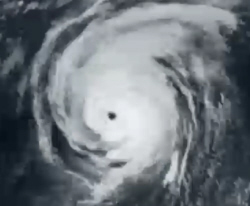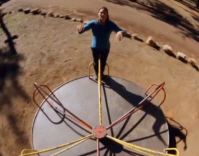The Coriolis Effect
The Swirl of the Hurricane
It's now early September. Although the summer is almost at an end, in the northern hemisphere it has a sting in its tail. Because this is hurricane season. The development of a hurricane is a wonderful example of how the Earth's spin controls our weather.

The Eye of the Hurricane
At this time of year, the Gulf of Mexico has the perfect ingredients to make a hurricane. The sea is relatively shallow and close to the equator, so the water gets particularly hot. The warm ocean heats the air above it, and once the air is warm, it expands and rises. As the warm air rises, the pressure drops, sucking in even more moist air, creating powerful winds.
But there's one final ingredient needed to create a hurricane. It needs tp start turning, and that rotation comes from the spin of the Earth
The powerful circulation of winds within a hurricane is generated by the Earth's spin, through a phenomenon known as the Coriolis effect. Now the Coriolis effect can be a little counterintuitive, but there's a great way of seeing how it works, with a ball and a children's roundabout.

Playground Roundabout
If two people stand on opposite sides of a stationary children's roundabout, one can throw a ball to the other with relative ease. This is not the case if you give the roundabout a push. If a ball is thrown on a rotating roundabout it curves, just as the planet's winds do.
Winds are drawn inwards towards the low pressure at the centre of the hurricane, but as they head towards the centre , the Coriolis effect makes them turn to the right.
This creates the hurricane's characteristic circular swirl of wind. It also means that the wind never reaches the centre of the storm. So the eye of the hurricane remains calm.
When you look at the Earth you can see some fairly obvious bands. white snow at the poles, yellow deserts and then green vegetation in the tropics. Each band reflects a dramatically different climate zone, with it's own distinctive weather. These major climate zones are caused by the spin of the Earth and the Coriolis effect.
To see how the Coriolis effect created these global climate bands, I've stayed on the equator and travelled into the highlands of Ecuador.
